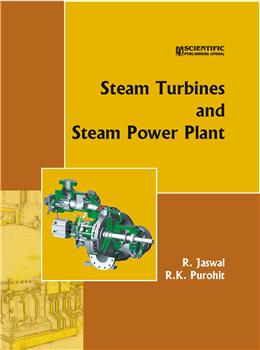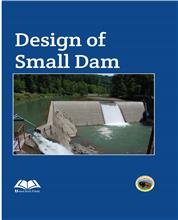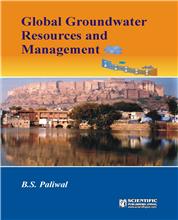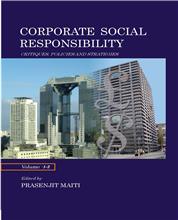1 Steam Turbines: Principles of Working and Velocity Triangles
1.1. Introduction
1.2. Classification of Steam Turbines
1.2.1. Impulse turbine
1.2.2. Impulse-reaction turbines
1.3. The Simple Impulse Turbine
1.3.1. Velocity diagram
1.3.2. The combined inlet and outlet velocity triangles
1.3.3. Work done and axial thurst
1.4. Compounding of Impulse Turbines
1.4.1. The pressure compounded (Rateau) impulse turbine
1.4.2. The velocity compounded (Curtis) impulse turbine
1.4.3. Pressure velocity compounded turbine
1.5. Impulse-Reaction Turbine
1.5.1. Thermodynamic means to reduce the rotor speed - compounding of reaction turbine
1.5.2. Degree of reaction and velocity diagram of reaction turbine
1.5.3. Height of blades of a reaction turbine
Illustrative Examples
2. Steam Turbines: Various Efficiencies Energy Losses, Construction Details and Components
2.1. Blading Efficiency
2.2. Optimum Operating Conditions
2.3. Calculations for Velocity Compounded Impulse Turbine
2.3.1. Advantages and limitations
2.4. Optimum blade speed ratio
2.5. Energy Losses in Steam Turbines
2.5.1. Internal Losses
2.5.2. External Losses
2.6. Seals
2.6.1. Labyrinth glands
2.7. Constructional Details of Nozzles and Diaphragms
2.8.1. Manufacturing methods
2.8.2. Material
2.8.3. Mounting turbine moving blades
2.9. Attachment of Blades to Rotor
Illustrative Examples
Exercises
3. Regenerative and Reheat Cycles
3.1. Introduction
3.2. Limitations of Carnot Cycle for Vapours
3.3. Rankine Cycle
3.3.1. Energy analysis of the ideal Rankine cycle
3.3.2. Actual Rankine Cycle
3.3.3. The effect of operating conditions on Rankine cycle efficiency
3.4. Comparison of Rankine and Carnot Cycles
3.5. Desirable Characteristics of a Good Working Fluid
3.6. Regenerative Feed Heating
3.6.1. Basic Principle
3.6.2. Most Ideal Regenerative Feed Heating Cycle
3.6.3. Steam bleding
3.6.4. Regenerative efficiency
3.7. Optimum Heater Location and Number of Heater used
3.8. Other Type Regenerative Feed Heating Arragements
3.8.1. Surface Heaters with one Drain Pump
3.8.2. Plain Surface Heaters with One Drain Pump and One Drain Cooler
3.8.3. Surface Heaters with Drain Fed to Hot-Well
3.9. Optimum Feed Water Temperature and Saving in Heat Rate
3.9.1. Gain in Thermal Efficiency Due to Regenerative Feed Heating
3.10. Advantages and Disadvantages of Regenerative Feed Heating Cycle over Rankine Cycle
3.11. Feed Water Heater
3.11.1. Open Feed Water Heaters
3.11.2. Closed Feed Water Heaters
3.12. Direct Contact (D.C.) Heaters
3.13. Surface Heaters
3.13.1. Desuperheating Zone
3.13.2. Condensing Zone
3.13.3. Direct Cooling Zone
3.13.4. Automatic Heater Bypassing
3.13.5. Tube Material
3.14. Deaerators
3.15. Reheat Cycle
Illustrative Examples
Exercises
4. Governing of Steam Turbines, Cogeneration, Mixed Pressure and Binary Vapour Cycle
4.1. Governing of Steam Turbines
4.1.1. Servomotor Governing
4.1.2. Throttle governing
4.1.3. Nozzle control governing
4.1.4. Comparison of throttle governing and nozzle control governing
4.1.5. By-pass governing
4.1.6. Selection of steam governing system
4.2. Emergence Tripping of Turbine
4.2.1. Annular overspeed governor
4.2.2. Annular overspeed governor with side suspension
4.2.3. Cylindrical overspeed governor
4.2.4. Cylindrical pilot valve
4.3. Comparison between Impulse and Reaction Turbines
4.4. Cogeneration
4.4.1. Back pressure turbine
4.4.2. Cogeneration with an extraction turbine (Pass out or bleeder)
4.5. Mixed Pressure Turbines
4.6. Binary Vapour Cycle
Illustrative Examples
Exercises
5. Steam Power Plants
5.1. Introduction
5.2. Steam Power Plant Layout
5.3. Site Selection for Steam Power Plants
5.4. Working Medium
5.5. Fuels and Fuel Handling Equipments
5.5.1. Methods of coal handling
5.5.2. Modern layout of fuel handling equipment
5.6. Ash Handling Equipments
5.7. Air Preheater
5.8. Feed Water Treatment
5.8.1. Mechanical treatment
5.8.2. Softening of water
5.8.3. Deaeration of degasification process
5.9. Fuel Combustion
5.9.1. Stoker firing
5.10. Classification of Stoker Firing
5.10.1. Over feed stoker
5.10.2. Underfeed Stoker
5.11. Types of Mechanical Stokers
5.11.1. Chain grate stoker
5.11.2. Travelling grate stoker
5.11.3. Spreader stoker
5.11.4. Vibrating grate stoker
5.11.5. Underfeed stokers
5.12. Pulverized Coal Firing System
5.12.1. Unit and Central System
5.12.2. Pulverizers
5.12.3. Pulverized coal burners
5.12.4. Fluidized bed combustion
5.13. Types of Boilers
5.14. Modern Developments in Steam Boilers
5.15. Cooling Tower
5.15.1. Induced draught cooling tower (Forced draught cooling tower)
5.15.2. Natural draught cooling towers
5.15.3. Dry Cooling Tower
Exercises





















